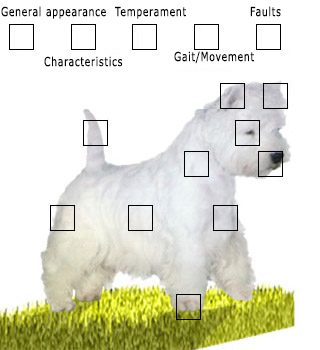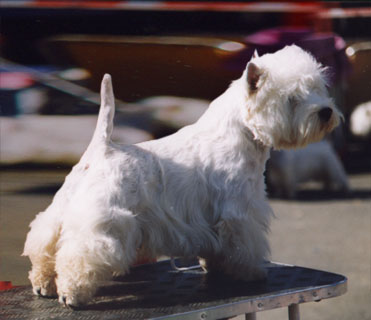
Our westys are beautiful, free of genetic diseases, of good character and healthy..
Below are the features that define the standards, you will discover what are the peculiarities that make our puppies perfect!

General appearance
Strongly built, deep in chest and back ribs; level back and powerful quarters on muscular legs and exhibiting in a marked degree a great combination of strength and activity.
Colour: white.
Size: Height at withers approximateiy 28 cms (11ins).
Temperament
Alert, gay, courageous, self reliant but friendly.
Faults
Any departure from the foregoing points should be considered a fault seriousness with which the fault should be regarded should be in exact proportion to its degree.
Note Male animals should have two apparentiy normal testicles fully descendent into the scrotum.
Head and Skull
Skull slightly domed; when handled across forehead presents a smooth colour.
Tapering very slightly from skull at level of ears to eyes. Distance from occiput to eyes slightly greater than length of foreface. Head thickly coated with hair, and carried at right angle or less, to axis of neck. Head not to be carried in extended position. Foreface gradually tapering from eye to muzzle. Distinct stop formed by heavy, bony ridges immediately above and slightly overhanging eye, and slight indentation between eyes. Foreface not dished or falling away quickly below eyes, where it is well made up. Jaws strong and level. Nose black and fairly large, forming smooth contour with rest of muzzle.
Nose not projecting forward.
Mouth
As broad between canine teeth as is consistent with varminty expression required.
Teeth large for size of dog, with regular scissor bite, i.e. upper teeth closely overlapping the lower teeth and set square to the jaws.
Tail
5 to 6 inches long, covered with harsh hair, no feathering, as straight as possibie, carried jauntily, not gay or carried over back. A long tail undesirable, and on no account should tails be docked.
Coat
Double coated. Outer coat consists of harsh hair, about 5 cms (2ins) long, free from any curl. Undercoat, which resembles fur, short, soft and dose. Open coats most undesirable.
Feet
Forefeet larger than hind, round, proportionate in size, strong, thickly padded and covered with short harsh hair. Hindfeet are smaller and thickly padded.
Under surface of pads and ali nails preferably black.
Characteristics
Small, active, game, hardy, possessed of no small amount of self-esteem with a varminty appearance.
Gait/Movement
Free, straight and easy all round, in front legs freely extended forward from shoulder. Hind movement free, strong and dose. Stifle and hocks well flexed and hocks drawn under body giving drive. Stiff, stilted movement behind the cow hocks highly undesirable.
Ears
Small, erect and carried firmly, terminating in sharp point, set neither too wide nor too dose.
Hair short and smooth (velvety), should not be cut. Free from any fringe at top.
Round pointed, broad, large or thick ears or too heavily coated with hair most undesirable.
Eyes
Set wide apart, medium in size, not full, as dark as possible. Slightly sunk in head, sharp and intelligent, which, looking from under heavy eyebrows, impart a piercing look. Light coloured eyes highly undesirable.
Neck
Sufficiently long to allow proper set on of head required, muscular and gradually thickening towards base allowing neck to merge into nicely sloping shoulders.
Hindquarters
Strong, muscular and wide across top. Legs short, muscular and sinewy. Thighs very muscular and not too wide apart. Hocks bent and well set in under body so as to be fairly dose to each other when standing or moving. Straight or weak hocks most undesirable.
Forequarters
Shoulders sloping backwards. Shoulder blades broad and lying dose to chest wall. Shoulder joint placed forward, elbows well in, allowing foreleg to move freely, parallel to axis of body.
Forelegs short and muscular, straight and thickly covered with short, hard hair.

